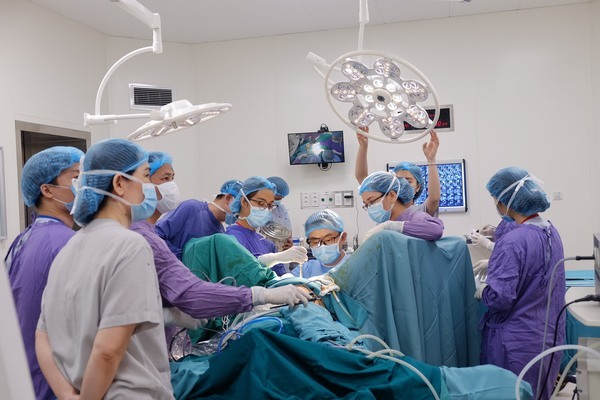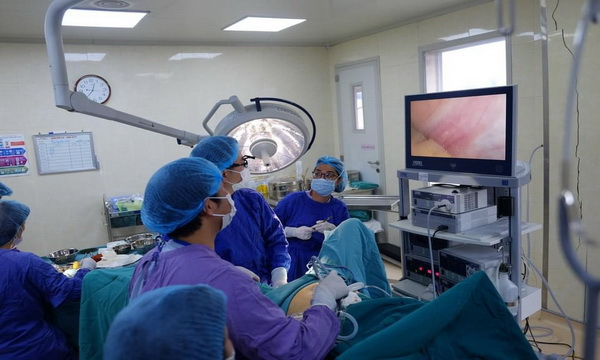After 29 years, patient finally diagnosed with male pseudohermaphroditism
When 'N', born in 1992 in Hanoi, was in high school, she realized that she was different from her peers.
When N., 29 years old, was in high school, she realized something was not normal about her physical boday and health, before knowing she was diagnosed with a rare condition.
She was in the 12th grade but still had not had a menstrual period. After having medical examinations at hospitals, she was told that she had no uterus and no vagina, but the cause was unknown, according to Vietnamnet.
After finishing high school, N had a boyfriend. She could not have sex in the normal way because her "way in" was too narrow. She felt ashamed and the couple broke up after many years of being together.
In March, she had a medical examination at a central hospital and her problem was diagnosed as non-vaginal syndrome.
After she had a CT scan and an MRI (magnetic resonance imaging), physicians discovered that the patient did not have a uterus but had a mass in the ovary position which was suspected to be testicles, ovaries or a mix of both testicles and ovaries.
A chromosome test showed the result as XY, which meant the patient's genetic sex was male. Gene testing on the Y chromosome showed that the genes that differentiate testicles were working normally.
The patient was diagnosed with male pseudohermaphroditism. N was then referred to E Hospital for further examination and intervention.
Pseudohermaphroditism, a condition in which the individual has a single chromosomal and gonadal sex but combines features of both sexes in the external genitalia, causing doubt as to the true sex. Female pseudohermaphroditism refers to an individual with ovaries but with secondary sexual characteristics or external genitalia resembling those of a male. Male pseudohermaphroditism refers to individuals whose gonads are testes but whose secondary sexual characteristics or external genitalia resemble those of a female.
Male pseudohermaphrodites are genetic males (45,XY) who develop female configurations and identities. These individuals have testes, but their genital ducts and external genitalia are female. Secondary sex characteristics may never appear in some, whereas others may achieve a fully feminized appearance. Male pseudohermaphroditism is rare and almost always results from autosomal recessive genetic defects (defects that must be inherited from both parents in order to be expressed). Several specific defects lead to feminization in genetic males. Each of these defects, by one mechanism or another, results in a loss of androgenic effects on body tissues. In rare instances, Leydig cells (the interstitial cells of the testes) are absent or greatly reduced in number, presumably because the receptors for luteinizing hormone (LH) are defective. Without Leydig cells, only small amounts of testosterone are produced. In other individuals there are enzyme deficiencies analogous to those that occur in female pseudohermaphrodites, although the enzyme deficiencies in males result in fetal androgen deficiency.
Dr Nguyen Dinh Minh, head of the Department of Maxillofacial, Plastic and Aesthetic Surgery at E Hospital, said the patient has a completely feminine appearance with long hair, lovely face, chest and genitals that look like other women. The outward sex is similar to that of a woman. The patient's psychology and sexual orientation are also of a female. However, the patient's vagina was very narrow and shallow.
In pseudohermaphroditism, a person is born with the primary sex characteristics of one sex but develops secondary sex characteristics.
Normally, a human body has both male and female hormones. Of these, the AR gene is the main gene that determines the activity of androgen receptors, or the receptors of male hormones. This gene, if mutated, will make the body insensitive to androgens generated from testicles.
The operation was done by surgeons from the Department of Maxillofacial, Plastic and Aesthetic Surgery and the department of Urology - Andrology and Obstetrics at E Hospital, with support from leading professors and experts, including Prof Tran Thiet Son, former head of the Plastic Surgery Department at Hanoi Medical University, Dr Tran Duc Phan, president of the Vietnam Medical Genetics Association, and Prof. Honorary Dang Van Duong, former head of the Pathology Department of Bach Mai Hospital.
Nguyen Dinh Lien, head of the Urology – Andrology Department at E Hospital, said during the operation, surgeons found a structural mass in the patient’s abdomen which looked like an oviduct embracing an ovary. However, they did not know if they were ovaries, testes or both ovaries and testes.
The team of surgeons stopped the operation and took a sample of tissue for a biopsy. The test showed that the mass was completely testicular, with a seminiferous tubule. The mass showed fibrosis and dysplasia that could easily lead to cancer.
“Normally, testicles must be in the scrotum. The environment inside the abdomen is hotter than the outside environment, so the risk of testicular cancer is very high. We removed the testicles to eliminate this risk,” Lien explained.
After surgery, the patient is in good condition. She is able to walk, and her vaginal cavity is spacious and stable. There is no pain in the abdomen.
The patient is expected to be discharged in the next few days.
Minh said the patient will be prescribed more drugs to enhance the female hormones which help the body become more feminine. Doctors have recommended abstaining from sex for three months after the date of discharge.
According to the doctor, pseudohermaphroditism should be detected as soon as possible so that the sex can be determined and medicines prescribed to increase hormones. However, the disorder is very difficult to detect unless patients are born with abnormalities in the genitals.
N, the patient, told VietNamNet that she had an inferiority complex for many years and she wanted to better understand herself.
N said she was shocked when she was told that she had male pseudohermaphroditism and questioned who she was. However, she pulled herself together after encouragement from the doctors.
“I tell myself that I am always a girl who loves dresses and songs, and lives with the love of my relatives and friends,” said the 29-year-old, adding that she has many plans for the future after she fully recovers.
Chau Polly

